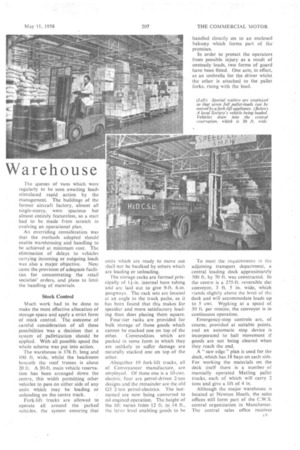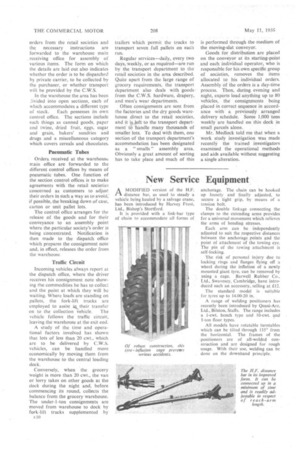Modern Aids Speed Work In Central Warehouse
Page 54

Page 55

Page 56

If you've noticed an error in this article please click here to report it so we can fix it.
BECAUSE of the extensive scope of the organization, the methods adopted by the CO-operative Wholesale Society, Ltd., . always repay examination. Nowhere is this more so than in connection with the C.W.S. main grocery warehouse and central transport department at Newton Heath, Manchester,. where, after careful study, a thorough-going ' mechanical handling system has been instituted.
Something like 3m packets are handled there annually, the grocery warehouse dealing with 70,000 tons of goods arid a further 50,000 tons being dealt with by the central transport smalls" section.
Bulk Supplies The function of the central warehouse is to receive in bulk grocery commodities from outside manufacturers, to break down those supplies and reassemble them to meet the requirements of district co-operative societies up and down the country who are members of the wholesale body. Large quantities of goods for the retail grocery departments are dispatched direct from the factories to the local shops or to the societies' depots. For various reasons, big amounts of commodities purchased from outside manufacturers, special products of C.W.S. factories, and small quantities of different lines may not justify direct transport
In this case the goods are brought to Newton Heath, which serves approximately 450 retail societies in a sector covering a broad belt across central England; the area includes such centres as Barrow-in-Furness. .Birmingham, Worcester and Scarborough. The commodities are what the C.W.S. chief engineer, Mr. G. K. 1:8 Medlock, A.M.I.Mech.E., describes as "infinitely variable," including everything -from cartons of bottled aspirin to sugar in sacks and cooked hams in cases.
The space demanded to handle the enormous quantities and varieties is naturally large and in the years just after the end of the War the C.W.S. faced a difficult accommodation problem. By 1948 it was decided that the most reasonable solution was to acquire an aircraft factory at Newton Heath, which had then become vacant, and to convert it for the purpose of the grocery warehouse and central transport department.
Up to that time retail societies' vehicles coming to collect grocery commodities were liable to quite serious delays, for the demand had out-run the warehouse which was then provided at the C.W.S. headquarters in Balloon Street, Manchester. The queues of vans which were regularly to be seen awaiting loads stimulated rapid action by the management. The buildings of the former aircraft factory, almost all single-storey, were spacious but almost entirely featureless, so a start had to be made from scratch in evolving an operational plan.
An overriding consideration was that the methods adopted should enable warehousing and handling to be achieved at minimum cost. The elimination of delays to vehicles carrying incoming or outgoing loads was also a major objective. Next came the provision of adequate facilities for concentrating the retail societies' orders, and plans to limit the handling of materials.
Stock Control Much work had to be done to make the most effective allocation of storage space and apply a strict form of stock control. The outcome of careful consideration of all these possibilities was a decision that a system of palletization should be applied. With alt possible speed the whole scheme was put into action.
The warehouse is 376 ft. long and 100 ft. wide, whilst the headroom beneath the roof trusses is about 20 ft. A 30-ft. main vehicle reservation has been arranged down the centre, this width permitting other vehicles to pass on either side of any units which may be loading or unloading on the centre track.
Fork-lift trucks are allowed to operate all around the Parked vehicles, the system ensuring that units which are ready to move out shall not he baulked by others which are loading or unloading.
The storage racks are formed principally of 11-in, internal bore tubing and are laid out to give 9-ft. 6-in. gangways. The rack sets are located at an angle to the truck paths, as it has been found that this makes for speedier and more satisfactory loading than does placing them square.
Four-tier racks are provided for bulk storage of those goods which cannot he stacked one on top of the other. Commodities which are packed in some form in which they are unlikely to suffer damage are naturally stacked one on top of the other.
Altogether 10 fork-lift trucks, all of Conveyancer manufacture, are employed. Of these one is a 10-cwt. electric, four are petrol-driven 2-ton designs and the remainder are the old G5 2-ton petrol-electrics. The lastnamed are now being converted to oil-engined operation. The height of the lift varies from-12 ft. to 14 ft., the latter level enabling goods to be To meet the requirements in the adjoining transport department, a central loading dock approximately 300 ft. by 70 ft. was constructed. In the centre is a 275-ft. reversible slat conveyor, 3 ft. 5 in. wide, which stands slightly above the level of the deck and will accommodate loads up to 5 cwt. Wosking at a speed of 30 ft. per minute, the conveyor is in continuous operation.
Emergency-stop controls are, of course, provided at suitable points, and an automatic stop device is incorporated to halt movement if goods are not being cleared when they reach the end.
A "saw edge "plan is used for the dock, which has 18 bays on each side. For working the materials on the deck itself there is a number of manually operated Matling pallet trucks, each of which will carry 2 tons and give a lift of 4 in.
Although the major warehouse is located at Newton Heath, the sales offices still form part of the C.W.S. central organization in Manchester. The central sales office receives orders from the retail societies and the necessary instructions are forwarded to the warehouse main . receiving office for assembly of various items. The form on which the details are laid out also indicates whether the order is to be dispatched by private carrier, to be collected by the purchaser, or whether transport will be provided by the C.W.S.
In the warehouse the area has been jivided into open sections, each of which accommodates a different type of stock. Each possesses its own control office. The sections include such things as canned goods, paper and twine, dried fruit, eggs, sugar and grain, bakers' sundries and drugs and a miscellaneous category which covers cereals and chocolates.
Pneumatic Tubes
Orders, received at the warehouse train office are forwarded to the different control offices by means of pneumatic tubes. One function of the section control offices is to make agreements with the retail societies concerned as customers to adjust their orders in such a way as to avoid; if possible, the breaking down of case, carton or unit pallet lots.
The control office arranges for the release of the goods and for their conveyance to an assembly point where the particular. society's order is being concentrated. Notification is then made to the dispatch office which prepares the consignment note and, in effect, releases the order from the warehouse.
Traffic Circuit Incoming vehicles always report at the dispatch office, where the driver receives his consignment note showing the commodities he has to collect and the point at which they will be waiting. Where loads are standing on pallets, the fork-lift trucks are employed to assist ik.,their transfer
on to the collection vehicle. The vehicle follows the traffic circuit, leaving the warehouse at the exit end.
A study of the time and operational factors involved has shown that lots of less than 20 cwt., which are to be delivered by C.W.S. vehicles, can be handled more economically by moving them from the warehouse to the central loading dock.
Conversely, when the grocery weight is more than 20 cwt., the van or lorry takes on other goods at the dock during the night and; before commencing its round, collects the balance from the grocery warehouse. The under-I -ton consignments are moved from warehouse to dock by fork-lift trucks supplemented by
E 10
trailers which permit the trucks to transport seven full pallets on each run.
Regular services—daily, every two days, weekly, or as required—are run by the transport department to the retail societies in the area described. Quite apart from the large range of grocery requirements, the transport department also deals with goods from the C.W.S. hardware, drapery, and men's wear departments.
Often consignments are sent from the factories and the dry goods warehouse direct to the retail societies, and it is left to the transport department to handle many thousands of smaller lots. To deal with them, one section of the transport department's accommodation has been designated as a " smalls" assembly area. Obviously a great amount of sorting has to take place and much of this is performed through the medium of the moving-slat conveyor.
Goods for .distribution are placed on the conveyor at its starting-point and each individual operator, who is responsible for his own specific group of societies, removes the items allocated to his individual orders. Assembly of the orders is a day-time process. Then, during evening and night, experts load anything up to 80 vehicles, the consignments being placed in correct sequence in accordance with a previously arranged delivery schedule. Some 1,000 tons weekly are handled on this dock in small parcels alone.
Mr. Medlock told me that when a work study investigation was made recently the trained investigators examined the operational methods and aids available without suggesting a single alteration.




























































































































